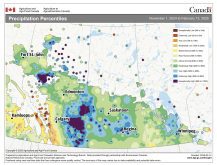This year, more than ever, financial returns are going to be highly variable for prairie grain farmers and this will influence decision making for 2022.
Farmer A: Yields were very poor due to drought and heat. There is no crop insurance because they believed it highly unlikely that they would ever grow such a small crop. Most of the crop was sold to a neighbouring cattle producer as green feed for $50 to $100 an acre. To add insult to injury, some grain was priced with deferred delivery contracts and they had to write a significant cheque to buy their way out of the contract shortfall.
Read Also

Saskatchewan looks to expand trade in Indonesia
Saskatchewan intends to increase its agricultural partnership with Indonesia.
Meanwhile, adjacent grain farms received $100 to $200 an acre from crop insurance on top of any returns from meagre yields and/or selling some crop as green feed. There’s a big difference in financial return between Farmer A and most others within the same geographic region.
Farmer B: Precipitation was slightly higher in this area. Crops were well below average, but not small enough to qualify for any significant crop insurance payments. Unfortunately, most of the production was contracted in advance of the big price run-up. Very little will be sold at the current high prices. What might have been a year to get ahead financially will instead have this young producer restructuring some debt.
Farmer C: In one of the luckier 2021 production regions, this farmer grew an almost average crop. Even though it was far from a bin-buster, very little of the crop was contracted in advance allowing most to be sold at the much higher prices, which materialized after harvest. While 35 bushel per acre canola is nothing to brag about, at $22 a bushel it’s a handsome return. This is actually the farm’s best financial year ever.
After reading the scenarios above, one of the takeaways might be the danger of contracting crops early in the season. Even on production contracts with an Act of God clause, locking in prices early was costly given how prices escalated. For those who had to buy their way out of deferred delivery contracts, the pain was even more acute.
However, leaving all your potential production unpriced in 2022 could be a mistake. All the conditions that aligned in 2021 may not happen again for a long time.
Some producers contracted an unreasonably large portion of what they hoped to produce and this is a situation to avoid. There will also be more appetite for contracts with an Act of God clause.
In canola, where Act of God contracts are not normally available, options can be used at a set cost to lock in a minimum price level.
Many 2022 contract prices are record high. Will market prices be even higher after the 2022 harvest? Perhaps, but perhaps not. New crop flax can be contracted at $24 a bu., mustard at 65 to 70 cents a pound and oats at more than $6.50 a bu.
Maybe you bought your fertilizer in the summer or early fall when urea was still around $700 a tonne, but maybe you’re buying it at $1,350 a tonne or higher. Expensive fertilizer still pencils well at current grain prices, but it’s tougher to pay for expensive fertilizer if grain prices drop to more traditional levels.
In 2021, crop contracts contributed to lower returns. Don’t let that overwhelm the analysis for 2022. The opposite could happen.















